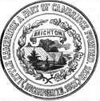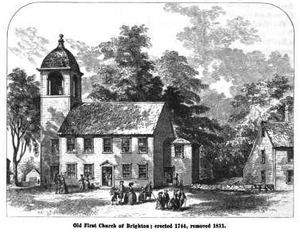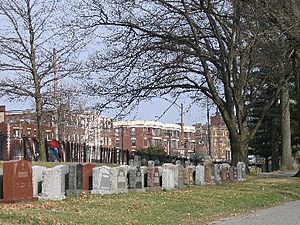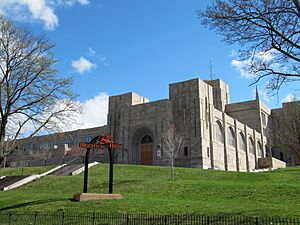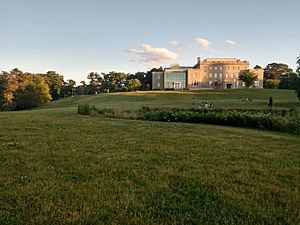Brighton, Boston facts for kids
Quick facts for kids
Brighton
|
||
|---|---|---|
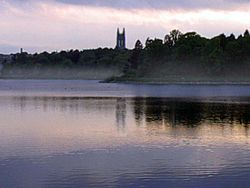
The Chestnut Hill Reservoir is located in the Brighton neighborhood. (Boston College can be seen in the background).
|
||
|
||
| Nicknames:
Little Cambridge, South Cambridge, Third Parish (all archaic)
|
||
| Country | United States | |
| State | Massachusetts | |
| County | Suffolk | |
| Neighborhood of | Boston | |
| Settled | 1630 | |
| Incorporated | February 24, 1807 | |
| Annexed by Boston | January 5, 1874 | |
| Area | ||
| • Land | 2.78 sq mi (7.2 km2) | |
| Population | ||
| • Total | 43,880 | |
| • Density | 15,784/sq mi (6,095/km2) | |
| Time zone | Eastern | |
| • Summer (DST) | Eastern | |
| Zip Code |
02135
|
|
| Area code(s) | 617 / 857 | |
Brighton is a lively neighborhood in Boston, Massachusetts, USA. It's located in the northwestern part of the city. Brighton was once a separate town. It got its name from the city of Brighton in England.
Originally, Brighton was part of Cambridge and was called "Little Cambridge." In 1807, it became its own town. Later, in 1874, it joined the city of Boston. For a long time, Brighton was a farming area with a busy market. The nearby neighborhood of Allston was also part of Brighton. Today, people often call the combined area "Allston–Brighton."
Contents
Brighton's Story: A Look Back in Time
In 1630, the land where Brighton is now was given to the town of Watertown. A few years later, in 1634, the Massachusetts Bay Colony changed its mind. They gave the land south of the Charles River to Newtowne, which soon became Cambridge.
In 1646, a missionary named Reverend John Eliot started a village for Native Americans who had become Christians. This village was on the border of what is now Newton and Brighton. The first English settlers came from Cambridge. They crossed the Charles River and started "Little Cambridge." This was Brighton's name before 1807.
Growing as a Farming Community
Before the American Revolutionary War, Little Cambridge was a small but successful farming area. It had fewer than 300 people. Some wealthy merchants from Boston lived there too.
A big change for Brighton happened in 1775. A cattle market was set up to provide food for the Continental Army. After the war, two men, Jonathan Winship I and Jonathan Winship II, became the biggest meat suppliers in Massachusetts.
Becoming Its Own Town
The people of Little Cambridge decided they wanted to be separate from Cambridge. Cambridge's government made choices that hurt the cattle business. They also didn't fix the main bridge connecting Little Cambridge to Cambridge. So, in 1807, the government allowed them to separate. Little Cambridge was then renamed Brighton.
In 1820, people started growing plants and flowers for sale. Over the next 20 years, Brighton became a very important place for gardening in the Boston area. But the cattle business was still very important. In 1834, the Boston & Worcester Railroad was built. This helped Brighton's cattle trade even more. By 1866, Brighton had 41 places where animals were processed for meat. These later became the Brighton Stock Yards.
Joining the City of Boston
In October 1873, the town of Brighton voted to join the city of Boston. In January 1874, Brighton officially became part of Boston. The population of Brighton grew quickly after that. It went from 6,000 people in 1875 to 47,000 by 1925.
Getting Around: Transportation in Brighton
Brighton has many ways to get around using public transportation. The Massachusetts Bay Transportation Authority (MBTA) runs the trains and buses.
Green Line Train Service
You can use the Green Line light rail. The B branch has 11 stops along Commonwealth Avenue in Brighton. It ends at the Boston College stop. The Cleveland Circle stop on the C branch is in southern Brighton. The Reservoir station on the D branch is also nearby.
Bus Routes and Commuter Rail
Brighton is also served by several MBTA bus routes. These include 57, 57A, 64, 65, 66, 70, 86, 501, and 503. You can also catch the MBTA Commuter Rail at the Boston Landing station on the Framingham/Worcester Line.
Brighton's Location: Where is it?
Brighton is connected to the rest of Boston through the Allston neighborhood. Other towns and cities surround it. These include Cambridge, Watertown, Newton, and Brookline. The Charles River separates Brighton from Cambridge and Watertown.
Brighton has a population of about 43,887 people. Its land area is about 2.78 square miles (7.2 square kilometers). Brighton is managed together with the nearby neighborhood of Allston. The two areas are often called "Allston–Brighton ." Together, they have a population of about 65,276 people.
Who Lives in Brighton? Demographics
In 2020, Brighton had an estimated population of 48,330 people. The neighborhood is quite diverse. Many different groups of people live there.
The average age of people in Brighton is about 29.3 years old. The largest group of people are between 25 and 34 years old. Many people in Brighton have also graduated from a four-year college.
The average price for a home in Brighton in 2020 was about $542,900. This is higher than the national average. Many homes in Brighton are older. About 39.8% of homes were built before 1939.
Learning in Brighton: Schools and Colleges
Brighton is home to many schools that are part of the Boston Public Schools system.
Elementary Schools
- Edison School
- Winship School
- Baldwin Pilot School
- Mary Lyon Lower School (Kindergarten to 8th grade)
Secondary Schools
- Boston Green Academy
- Brighton High School
- Mary Lyon Upper Pilot High School (9th to 12th grade)
- Saint Joseph Preparatory High School
Brighton also has other schools, including Saint Columbkille's School (K–8) and St. Joseph's Preparatory Academy. The EF International Language School is also located here.
Brighton is home to parts of Boston College. It also has Saint John's Seminary. Many students and teachers from nearby colleges like Boston University also live in Brighton.
Famous People from Brighton
Many interesting people have connections to Brighton:
- Michael Bloomberg: Former mayor of New York City.
- Fred Cusick: A famous announcer for the Boston Bruins hockey team.
- Steve DeOssie: A former professional football player for the NFL.
- William F. Galvin: The Secretary of State for Massachusetts.
- Beth Howland: An actress.
- John F. Kelly: A former Secretary of Homeland Security for the U.S.
- Joseph P. Kennedy II: A former U.S. Congressman.
- John Krasinski: A well-known film actor, director, and writer.
- Dennis Lehane: An author who wrote "Mystic River."
- Amy Poehler: A famous actress, writer, and comedian.
- Simon Shnapir: An American Olympic medalist in ice skating.
- Noah Welch: A professional hockey player and U.S. Olympic Team Member.
See also
 In Spanish: Brighton (Boston) para niños
In Spanish: Brighton (Boston) para niños


